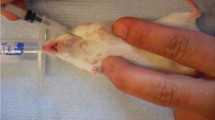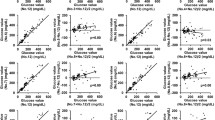Abstract
Epinephrine (E) and norepinephrine (NE) play a major role in regulating metabolism and cardiovascular physiology. Both are secreted in response to stress and their measurement in plasma allows the study of sympathoadrenal function. Several studies investigating sympathoadrenal physiology are conducted using mice. Review of the literature revealed that basal mouse NE and E plasma concentrations range within 4–140 nM depending on the blood sampling method. Such variability doesn't allow study comparison and may conceal catecholamine variations in response to stress. Therefore, our aim was to determine a reliable sampling method to measure mouse plasma catecholamine concentrations. Results showed that arterial catheterization is the most accurate sampling method: E and NE basal levels were similar to those found in humans (1.1±0.3 nM and 4.1±0.5 nM, respectively). Retro-orbital bleeding led to analogous results. On the contrary, decapitation was stressful for mice and consequently NE and E concentrations were high (24.6±2.7 nM and 27.3±3.8 nM, respectively). These different bleeding methods were compared in terms of their ability to detect sympathoadrenal system stimulation (cold-pressure test). With catheter and retro-orbital samplings the expected increase in NE and E levels was easily perceived. In contrast, with decapitation no significant change in E was detected. In conclusion, arterial-catheter and retro-orbital blood sampling methods appear to be the most accurate procedures for studying the sympathetic nervous system in mice in both unstressed and stressed conditions.


Similar content being viewed by others
References
Baum D, Halter JB, Taborsky GJ Jr, Porte D Jr (1985) Pentobarbital effects on plasma catecholamines: temperature, heart rate, and blood pressure. Am J Physiol 248:E95–E100
Bornstein SR, Tian H, Haidan A, Bottner A, Hiroi N, Eisenhofer G, McCann SM, Chrousos GP, Roffler-Tarlov S (2000) Deletion of tyrosine hydroxylase gene reveals functional interdependence of adrenocortical and chromaffin cell system in vivo. Proc Natl Acad Sci USA 97:14742–14747
Bottner A, Haidan A, Eisenhofer G, Kristensen K, Castle AL, Scherbaum WA, Schneider H, Chrousos GP, Bornstein SR (2000) Increased body fat mass and suppression of circulating leptin levels in response to hypersecretion of epinephrine in phenylethanolamine-N-methyltransferase (PNMT)-overexpressing mice. Endocrinology 141:4239–4246
Carruba MO, Bondiolotti G, Picotti GB, Catteruccia N, Da Prada M (1987) Effects of diethyl ether, halothane, ketamine and urethane on sympathetic activity in the rat. Eur J Pharmacol 134:15–24
Dash R, Kadambi V, Schmidt AG, Tepe NM, Biniakiewicz D, Gerst MJ, Canning AM, Abraham WT, Hoit BD, Liggett SB, Lorenz JN, Dorn GW 2nd, Kranias EG (2001) Interactions between phospholamban and beta-adrenergic drive may lead to cardiomyopathy and early mortality. Circulation 103:889–896
Grouzmann E, Fathi M, Gillet M, de Torrente A, Cavadas C, Brunner H, Buclin T (2001) Disappearance rate of catecholamines, total metanephrines, and neuropeptide Y from the plasma of patients after resection of pheochromocytoma. Clin Chem 47:1075–1082
Hein L, Altman JD, Kobilka BK (1999) Two functionally distinct alpha2-adrenergic receptors regulate sympathetic neurotransmission. Nature 402:181–184
Herijgers P, Leunens V, Tjandra-Maga TB, Mubagwa K, Flameng W (1996) Changes in organ perfusion after brain death in the rat and its relation to circulating catecholamines Transplantation 62(3):330–335
Jacobson L (1999) Lower weight loss and food intake in protein-deprived, corticotropin releasing hormone-deficient mice correlate with glucocorticoid insufficiency. Endocrinology 140:3543–3551
Jeong KH, Jacobson L, Pacak K, Widmaier EP, Goldstein DS, Majzoub JA (2000) Impaired basal and restraint-induced epinephrine secretion in corticotropin-releasing hormone-deficient mice. Endocrinology 141:1142–1150
Kobayashi K, Ota A, Togari A, Morita S, Mizuguchi T, Sawada H, Yamada K, Nagatsu I, Matsumoto S, Fujita K (1995) Alteration of catecholamine phenotype in transgenic mice influences expression of adrenergic receptor subtypes. J Neurochem 65:492–501
Melo LG, Veress AT, Ackermann U, Steinhelper ME, Pang SC, Tse Y, Sonnenberg H (1999) Chronic regulation of arterial blood pressure in ANP transgenic and knockout mice: role of cardiovascular sympathetic tone. Cardiovasc Res 43:437–444
Melo LG, Veress AT, Chong CK, Ackermann U, Sonnenberg H (1999) Salt-sensitive hypertension in ANP knockout mice is prevented by AT1 receptor antagonist losartan. Am J Physiol 277:R624–R630
Thomas SA, Palmiter RD (1997) Impaired maternal behavior in mice lacking norepinephrine and epinephrine. Cell 91:583–592
Tsunoda M, Takezawa K, Yanagisawa T, Kato M, Imai K (2001) Determination of catecholamines and their 3-O-methyl metabolites in mouse plasma. Biomed Chromatogr 15:41–44
Wiesel P, Mazzolai L, Nussberger J, Pedrazzini T (1997) Two-kidney, one clip and one-kidney, one clip hypertension in mice. Hypertension 29:1025–1030
Yamada J, Sugimoto Y, Noma T (2000) Involvement of adrenaline in diazepam-induced hyperglycemia in mice. Life Sci 66:1213–1221
Acknowledgements
The present study was supported by grants from the Swiss National Found for Scientific Research FNSRS (EG: number 31–65'068.01.1; LM: number 3200–066371.01)
Author information
Authors and Affiliations
Corresponding author
Rights and permissions
About this article
Cite this article
Grouzmann, E., Cavadas, C., Grand, D. et al. Blood sampling methodology is crucial for precise measurement of plasma catecholamines concentrations in mice. Pflugers Arch - Eur J Physiol 447, 254–258 (2003). https://doi.org/10.1007/s00424-003-1140-x
Received:
Revised:
Accepted:
Published:
Issue Date:
DOI: https://doi.org/10.1007/s00424-003-1140-x




